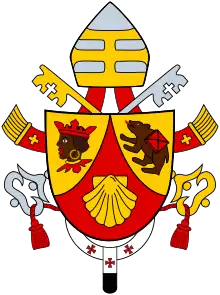Cardinals created by Benedict XVI
Pope Benedict XVI (r. 2005–2013) created 90 cardinals in five consistories. With three of those consistories he respected the limit on the number of cardinal electors set (but temporarally exceeded) by his predecessors at 120.[lower-alpha 1] He exceeded that limit at the other two consistories, reaching as high as 125 in 2012.
.JPG.webp)
With the consistory of February 2012, a majority of the cardinal electors had been named cardinals by him, 63 of 125.
Cardinal electors
Benedict's first, second and last consistories brought the number of cardinal electors to 120.
The 2010 consistory produced 121 electors, until Cardinal Bernard Panafieu turned 80 two months later on 26 January 2011. After the consistory of February 2012, there were 125 electors, and the count returned to 120 on 26 July after the 80th birthdays of Cardinals Rodolfo Quezada Toruño, Edward Michael Egan, Miloslav Vlk, Henri Schwery, and James Francis Stafford.
24 March 2006
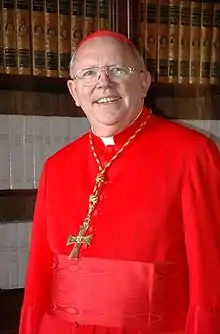
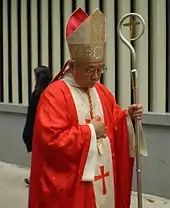
Pope Benedict XVI created new cardinals for the first time on 24 March 2006. He announced the names of fifteen new cardinals from eleven different countries on 22 February.[7][8] Three belonged to the Roman Curia, nine headed a diocese, and two were bishops emeritus. One, Albert Vanhoye, was a Jesuit priest and theologian, not a bishop. Twelve of the fifteen were under 80 years old and eligible to vote in a papal conclave. With these new cardinals, Benedict limited the number of cardinal electors to 120, the maximum set by statute since 1973[1] and which John Paul II had at times exceeded. The appointments brought the total number of cardinals to 193.[lower-alpha 2]
- William Levada (1936-2019)
- Franc Rode (b. 1934)
- Agostino Vallini (b. 1940)
- Jorge Urosa (b. 1942)
- Gaudencio Rosales (b. 1932)
- Jean-Pierre Ricard (b. 1944)
- Antonio Cañizares Llovera (b. 1945)
- Nicolas Cheong Jin-suk (b. 1931)
- Seán Patrick O'Malley (b. 1944)
- Stanisław Dziwisz (b. 1939)
- Carlo Caffarra (1938–2017)
- Joseph Zen Ze-kiun (b. 1932)
- Andrea Cordero Lanza di Montezemolo (1925–2017)
- Peter Poreku Dery (1918–2008)
- Albert Vanhoye (b. 1923)
24 November 2007


Pope Benedict announced the appointment of 23 new cardinals on 17 October 2007, scheduling a consistory for 24 November. Eighteen of the 23 cardinals were under 80. After the consistory, the College of Cardinals had 201 members, of whom 120 were eligible to vote in a papal election.[9][lower-alpha 3][10]
He announced that he had intended to make Bishop Ignacy Jeż of Koszalin-Kołobrzeg, Poland, who died on 16 October, a cardinal as well.[9]
- Leonardo Sandri (b. 1943)
- John Patrick Foley (1935–2011)
- Giovanni Lajolo (b. 1935)
- Paul Josef Cordes (b. 1934)
- Angelo Comastri (b. 1943)
- Stanisław Ryłko (b. 1945)
- Raffaele Farina (b. 1933)
- Agustín García-Gasco Vicente (1931–2011)
- Seán Brady (b. 1939)
- Lluís Martínez Sistach (b. 1937)
- André Vingt-Trois (b. 1942)
- Angelo Bagnasco (b. 1943)
- Théodore-Adrien Sarr (b. 1936)
- Oswald Gracias (b. 1944)
- Francisco Robles Ortega (b. 1949)
- Daniel DiNardo (b. 1949)
- Odilo Scherer (b. 1949)
- John Njue (b. 1944)
- Emmanuel III Delly (1927–2014)
- Giovanni Coppa (1925–2016)
- Estanislao Esteban Karlic (b. 1926)
- Urbano Navarrete Cortés (1920–2010)
- Umberto Betti (1922–2009)
20 November 2010
Benedict announced the names of 24 new cardinals on 10 October 2010, scheduling a consistory for 20 November. Fifteen were Europeans, including ten Italians, seven of whom were senior members of the Roman Curia. Twenty were under 80 years old. This consistory brought the number of cardinals to 203, of whom 121 were eligible to vote in a conclave.[11][12][13]
- Angelo Amato (b. 1938)
- Antonios Naguib (b. 1935)
- Robert Sarah (b. 1945)
- Francesco Monterisi (b. 1934)
- Fortunato Baldelli (1935–2012)
- Raymond Leo Burke (b. 1948)
- Kurt Koch (b. 1950)
- Paolo Sardi (1934–2019)
- Mauro Piacenza (b. 1944)
- Velasio de Paolis (1935–2017)
- Gianfranco Ravasi (b. 1942)
- Medardo Joseph Mazombwe (1931–2013)
- Raúl Eduardo Vela Chiriboga (b. 1934)
- Laurent Monsengwo Pasinya (b. 1939)
- Paolo Romeo (b. 1938)
- Donald Wuerl (b. 1940)
- Raymundo Damasceno Assis (b. 1937)
- Kazimierz Nycz (b. 1950)
- Malcolm Ranjith (b. 1947)
- Reinhard Marx (b. 1953)
- José Manuel Estepa Llaurens (1926–2019)
- Elio Sgreccia (1928–2019)
- Walter Brandmüller (b. 1929)
- Domenico Bartolucci (1917–2013)
18 February 2012
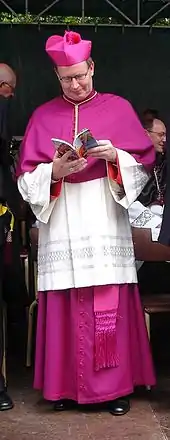
Benedict announced the names of 22 new cardinals on 6 January 2012, with a consistory set for 18 February. Eighteen were young enough to be cardinal electors. Sixteen were Europeans, including seven Italians. Ten held Vatican offices. With these additions, the number of cardinal electors increased from 107 to 125, a majority of them (63) named by Benedict.[14][15] Though the number of cardinal electors exceeded the limit of 120,[14] nine of them were due to turn eighty before the end of the year. Only Pope John Paul II's consistories in 2001 and 2003 had produced a larger number of electors, 135. The consistory of February 2012 brought the total number of cardinals to 213.[lower-alpha 4]
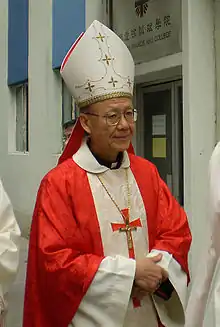
- Fernando Filoni (b. 1946)
- Manuel Monteiro de Castro (b. 1938)
- Santos Abril y Castelló (b. 1935)
- Antonio Maria Vegliò (b. 1938)
- Giuseppe Bertello (b. 1942)
- Francesco Coccopalmerio (b. 1938)
- João Braz de Aviz (b. 1947)
- Edwin Frederick O'Brien (b. 1939)
- Domenico Calcagno (b. 1943)
- Giuseppe Versaldi (b. 1943)
- George Alencherry (b. 1945)
- Thomas Christopher Collins (b. 1947)
- Dominik Duka (b. 1943)
- Wim Eijk (b. 1953)
- Giuseppe Betori (b. 1947)
- Timothy M. Dolan (b. 1950)
- Rainer Woelki (b. 1956)
- John Tong Hon (b. 1939)
- Lucian Mureșan (b. 1930)
- Julien Ries (1920–2013)
- Prosper Grech (1925-2019)
- Karl Josef Becker (1928–2015)
24 November 2012
On 24 October 2012, during a meeting of the Synod of Bishops, Benedict announced he would create six cardinals at a consistory on 24 November. At the time, there were 116 cardinal electors, with two set to turn 80 in the next month. The six new cardinals would bring that number to 120.[16] The November consistory brought the total number of cardinals to 211.[lower-alpha 5] Those named contrasted with those of the previous consistory, who had been criticized as "too Italian and too curial". Benedict said that "this little consistory" was meant to "complete" the earlier one "with a gesture of the universality of the Church".[17][18]
- James Michael Harvey (b. 1949)
- Bechara Boutros al-Rahi (b. 1940)
- Baselios Cleemis Thottunkal (b. 1959)
- John Onaiyekan (b. 1944)
- Rubén Salazar Gómez (b. 1942)
- Luis Antonio Tagle (b. 1957)
See also
Notes
- Pope Paul set the maximum at 120 in 1973,[1] after having raised the number to 134 in 1969.[2] Pope John Paul II confirmed the 120 limit in 1996,[3][4] though he twice raised the number of cardinal electors to 135, in February 2001[5] and again in October 2003.[6]
- 183 cardinals at 2005 conclave minus 1 cardinal elected pope (Ratzinger) minus 4 cardinals who died before the 2006 consistory (Sin, Caprio, Scheffczyk, Taofinuʻu) plus 15 newly-appointed cardinals.
- At the time of consistory announcement (17 October 2007), there were 121 cardinal electors and 202 cardinals in total including those to be appointed. However, the death of cardinal Stephen Fumio Hamao on 8 November 2007 reduced those numbers to 120 and 201 respectively before the consistory.
- 203 cardinals at 2010 consistory minus 12 cardinals who died before the consistory of February 2012 (Navarrete Cortés, Giordano, Vithayathil, Saldarini, García-Gasco Vicente, Sterzinsky, Świątek, Noè, Ambrozic, Deskur, Foley, Bevilacqua) plus 22 newly-appointed cardinals.
- 213 cardinals at the previous consistory minus 8 cardinals who died before the consistory of November 2012 (Sánchez, Daoud, Aponte Martinez, Quezada Toruño, Sales, Shan Kuo-hsi, Martini, Baldelli) plus 6 newly-appointed cardinals.
References
- "Announcement of Consistory for 15 New Cardinals". Zenit. 22 February 2006. Retrieved 22 August 2017.
- Pope Paul VI (1 October 1975). "Romano Pontifici Eligendo". Libreria Editrice Vaticana. Retrieved 12 July 2018. Cite journal requires
|journal=(help) See also: Romano Pontifici Eligendo. - Pope John Paul II (22 February 1996). "Universi Dominici Gregis". Libreria Editrice Vaticana. Retrieved 12 July 2018. Cite journal requires
|journal=(help) See also: Universi Dominici Gregis. - Allen Jr., John L. (23 July 2002). Conclave: The Politics, Personalities, and Process of the Next Papal Election. Cr Publishing. ISBN 9780385504560. Retrieved 12 July 2018.
- Stanley, Alessandra (22 February 2001). "Shaping a Legacy, Pope Installs 44 Cardinals". New York Times. Retrieved 12 July 2018.
- Bruni, Frank (22 October 2003). "Pope Confirms Cardinals, As Talk Turns to Succession". New York Times. Retrieved 12 July 2018.
- "Benedict XVI Names 15 New Cardinals". Zenit. 22 February 2006. Retrieved 22 August 2017.
- "Assegnazione dei Titoli e delle Diaconie ai Nouvi Cardinali" (Press release) (in Italian). Holy See Press Office. 24 March 2006. Retrieved 6 June 2018.
- "Pope Names 23 New Cardinals". Zenit. 17 October 2007. Retrieved 22 August 2017.
- Allen Jr., John L. (17 October 2007). "Complete List of New Cardinals". National Catholic Reporter. Retrieved 24 August 2017.
- Allen Jr., John L. (20 October 2010). "Wuerl and Burke among 24 new cardinals". National Catholic Reporter. Retrieved 24 August 2017.
- "Benedict XVI Names 24 New Cardinals". Zenit. 20 October 2010. Retrieved 24 August 2017.
- Galleazzi, Giacomo (20 November 2010). "Concistoro: nuovi operai nella vigna del Signore". La Stampa (in Italian). Retrieved 24 August 2017.
- Galeazzi, Giacomo (6 January 2012). "Oltre quota 120". La Stampa (in Italian). Archived from the original on 13 July 2018. Retrieved 25 August 2017.
- Allen Jr., John L. (6 January 2012). "Pope names 22 new cardinals, including Dolan and O'Brien". National Catholic Reporter. Retrieved 25 August 2017.
- Allen Jr., John L. (24 October 2012). "Pope to name six new cardinals". National Catholic Reporter. Retrieved 24 August 2017.
- Galeazzi, Giacomo (24 November 2012). "Consistoro". La Stampa (in Italian). Retrieved 24 August 2017.
- Pope Benedict XVI (27 October 2012). "Address of His Holiness Pope Benedict XVI during the Final General Congregation of the XIII Ordinary General Assembly of the Synod of Bishops". Libreria Editrice Vaticana. Retrieved 11 July 2018.
My intention, with this little Consistory, to complete the Consistory in February, precisely in the context of the new evangelization with a gesture of the Church’s universality, showing that the Church is the Church of all peoples, speaking all languages. She is always the Church of Pentecost; she is not the Church of a continent but the universal Church.
Cite journal requires|journal=(help)

